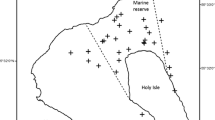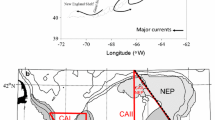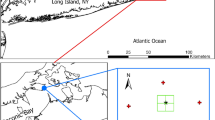Abstract
In the presence of the first recorded red tide (Ptychodiscus brevis) outbreak in North Carolina, autumn 1987 recruitment of bay scallops (Argopecten irradians concentricus) in the state’s most productive scallop beds was a virtual failure. Recruitment averaged across all of Bogue and Back sounds was only 2% of the mean of three previous red tide-free (control) years. Only from central Core Sound northward, where the red tide occurred later and not as intensively, was bay scallop recruitment normal (93% of control years). Mortality of adult scallops from early December 1987 to late January 1988, while red tide was at bloom concentrations but fishing was prohibited, was 21%. No comparable natural mortality data exist for control years because intense fishing mortality in this period is confounded with natural mortality. Data on abundance of articulated pairs of empty shells strongly suggest that the red tide caused mortality of both adult and newly recruited bay scallops. Bay scallop recruitment in autumn 1988 again failed to restock the traditionally productive scallop beds in western Bogue Sound and in Back Sound, perhaps because the only concentrations of spawners surviving the red tide in central Core Sound and further north were too far distant for successful transport of bay scallop larvae in sufficient abundance to these traditional beds. This potential explanation implies continuing impact of the red tide on North Carolina’s bay scallop fishery until spawning populations increase in Back Sound and western Bogue Sound.
Similar content being viewed by others
Literature Cited
Bricelj, V. M., J. Epp, andR. E. Malouf. 1987. Intraspecific variation in reproductive and somatic growth cycles of bay scallopsArgopecten irradians.Marine Ecology Progress Series 36: 123–137
Cosper, E. M., E. J. Carpenter, andV. M. Bricelj. 1989. Novel Phytoplankton Blooms: Causes and Impacts of Recurrent Brown Tides and Other Unusual Blooms. Springer Verlag, Hamburg. 799 p.
Cosper, E. M., W. C. Dennison, E. J. Carpenter, V. M. Bricelj, J. G. Mitchell, S. H. Kuentsner, D. Colflesh, andM. Dewey. 1987. Recurrent and persistent “brown tide” blooms perturb coastal marine ecosystem.Estuaries 10:284–290.
Duggan, W. P. 1973. Growth and survival of the bay scallop,Argopecten irradians, at various locations in the water column and at various densities.Proceedings of the National Shellfisheries Association 63:68–71.
Gainey, L. F., andS. E. Shumway. 1988. A compendium of the responses of bivalve molluscs to toxic dinoflagellates.Journal of Shellfish Research 7:623–628.
Karlson, R. H., andD. R. Levitan. 1990. Recuritment limitation in open populations ofDiadema antillarum: An evaluation.Oecologia 82:40–44.
Kellogg, R. L. and D. Spitsbergen. 1983. Predictive growth model for the meat weight (adductor muscle) of bay scallops in North Carolina. UNC Sea Grant Publ., UNC-SG-WP-83-6, Raleigh, North Carolina, 44 p.
Mercaldo, R. S. andE. W. Rhodes. 1982. Influence of reduced salinity on the Atlantic bay scallopArgopecten irradians (Lamarck) at various temperatures.Journal of Shellfish Research 2:177–181.
Ogata, T., M. Kodama, Y. Fukuyo, T. Inoue, H. Kamiya, F. Matsuura, K. Sekiguchi, andS. Watanabe. 1982. The occurrence ofPhotogonyaulax spp. in Ofunato Bay, in association with the toxification of the scallopPlatinopectin yessoensis.Bulletin of the Japanese Society of Scientific Fisheries 48:563–566.
Ogata, T., T. Ishimaru, andM. Kodama. 1987. Effect of water temperature and light intensity on growth rate and toxicity change inProtogonyaulax tamarensis.Marine Biology 95: 217–220.
Paerl, H. W. 1988. Nuisance phytoplankton blooms in coastal, estuarine, and inland waters.Limnology and Oceanography 33(4, part 2): 823–847.
Peterson, C. H., H. C. Summerson, S. R. Fegley, andR. C. Presgott. 1989. Timing, intensity, and sources of autumn mortality of adult bay scallops,Argopecten irradians concentricus Say.Journal of Experimental Marine Biology and Ecology 127: 121–140.
Prakash, A. 1967. Growth and toxicity of marine dinoflagel-lateGonyaulax tamarensis.Journal of the Fisheries Research Board of Canada 24:1589–1606.
Quayle, D. B. 1969. Paralytic shellfish poisoning in British Columbia.Fisheries Research Board of Canada Bulletin 168.
Rasmussen, E. 1977. The wasting disease of eelgrass (Zostera marina) and its effects on environmental factors and fauna, p. 1–52.In C. P. McRoy and C. Helfferich (eds.), Seagrass Ecosystems: A Scientific Perspective. Marcel Dekker, New York.
Steidinger, K. A. 1983. A re-evaluation of toxic dinoflagellate biology and ecology.Progress in Phycology Research 2:147–188.
Steidinger, K. A., M. Burklew, andR. Ingle. 1973. The effects ofGymnodinium breve toxin on estuarine animals, p. 179–202.In D. Martin and G. Padilla (eds.), Marine Pharmacognosy. Academic Press, New York.
Sutherland, J. P. 1987. Recruitment limitation in a tropical intertidal barnacle,Tetraclita panamensis (Pilsbry), on the Pacific Coast of Costa Rica.Journal of Experimental Marine Biology and Ecology 113:267–282.
Tangen, K. 1983. Shellfish poisoning and the occurrence of potentially toxic dinoflagellates in Norwegian waters.,Sarsia 68:1–7.
Tenore K. R. 1972. Macrobenthos of the Pamlico River estuary, North Carolina.Ecological Monographs 42:51–69.
Tester, P. A. andP. K. Fowler. 1990. Brevetoxin contamination ofMercenaria mercenaria andCrassostrea virginica: A management issue, p. 499–503.In E. Graneli, D. M. Anderson, L. Edler, and B. Sundstrom (eds.), Toxic Marine Phytoplankton, Elsevier, Amsterdam.
Tester, P. A. R. P. Stumpf, F. M. Vukovich, P. K. Fowler, and J. T. Turner. In press. An expatriate red tide bloom: Transport, distribution, and persistence.Limnology and Oceanography 36.
Tettelbach, S. T., P. J. Auster, E. W. Rhodes, andJ. C. Widman. 1985. A mass mortality of northern bay scallops,Argopecten irradians irradians, following a severe spring rainstorm.Veliger 27:381–385.
Thayer, G. W. andH. H. Stuart. 1974. The bay scallop makes its bed of eelgrass.U.S. National Marine Fisheries Service, Marine Fisheries Review 36:27–39.
Tracey, G. A. 1988. Feeding reduction, reproductive failure, and mortality inMytilus edulis during the 1985 ‘brown tide’ in Narragansett Bay, Rhode Island.Marine Ecology Progress Series 50:73–81.
Author information
Authors and Affiliations
Rights and permissions
About this article
Cite this article
Summerson, H.C., Peterson, C.H. Recruitment failure of the bay scallop,Argopecten irradians concentricus, during the first red tide,Ptychodiscus brevis, outbreak recorded in North Carolina. Estuaries 13, 322–331 (1990). https://doi.org/10.2307/1351923
Received:
Accepted:
Issue Date:
DOI: https://doi.org/10.2307/1351923




